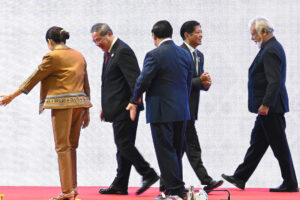Lao National Convention Center in Vientiane, Lao PDR. — PPA POOL PHOTO BY REVOLI CORTEZ
It was certainly a proud moment in the history of Philippine foreign relations. Speaking at the ASEAN gathering in Laos last week, “Philippine President Ferdinand Marcos challenged Chinese Premier Li Qiang over recent clashes in the South China Sea,” AFP reported on Oct. 10. As a diplomat attending the meeting told reporters: “you cannot separate economic cooperation from political security.” And indeed, Marcos the Younger was fully in the right when he “told the meeting that ASEAN and China cannot pretend that all is well on the economic front when there are tensions on the political front.”
Which leads us to what my BusinessWorld colleague (and one of the country’s finest columnists) Nonoy Oplas wrote recently: “The share of China in total Philippine imports keeps rising, from 20% in 2018 to 26% in January to July this year. The share of China in our exports remains flat at 13% from 2018 to 2024.
“The above numbers seem to contradict the frequent narrative and surveys that say Filipinos distrust China,” he wrote in his column, My Cup of Liberty (“Low unemployment and more trade with more countries,” Oct. 10). “Of every $4 of Philippines imports, $1 is from China — from toys, shoes, and electronics to trucks, buses, and bulldozers.”
As BusinessWorld itself reported on Oct. 11 (“Trade gap widens to $4.38B in August”), of our total trade, “62.2% was imported goods, while the remaining 37.8% was made up of exports.” And the “value of imported goods rose by 2.7% to $11.12 billion in August from $10.83 billion a year prior. Meanwhile, imports of raw materials and intermediate goods grew by 5.2% year on year to $4.06 billion in August. This made up 36.5% of total imports.”
However, more significantly from the national security perspective, “imported capital goods picked up by 9.6% annually to $3 billion, while imports of consumer goods was steady at $2.24 billion. Imports of mineral fuels, lubricants and related materials slid by 9.1% to $1.79 billion in August.”
And our biggest source of imports? “China was the biggest source of imports valued at $2.79 billion, accounting for a quarter of the total import bill in August.” The Philippines thus has a trade deficit with China at nearly $2 billion.
There is clearly an urgent need for the Philippines to decouple its economy from China. For one, it will allow our domestic manufacturing and other industries to grow, not be suffocated by Chinese competition, what with the latter’s advantages of a managed currency, government subsidies, lower wages, and lower electricity costs.
Another reason has to do with ensuring a policy consistent with Philippine democratic values, which is clearly at odds with China’s more autocratic and less human rights-oriented leanings:
“China today also has a clearly more authoritarian system than western democracies. And China is still much poorer than its democratic counterparts, despite being the world’s second-largest economy. China’s GDP per capita is not even a fifth of that of the US, and it is facing major economic challenges of its own,” wrote Renaud Foucartte in The Conversation (“Nobel economics prize: how colonial history explains why strong institutions are vital to a country’s prosperity — expert Q&A,” Oct. 14).
The truth is, “Xi Jinping’s increasingly authoritarian regime is the reason why China’s economy is ‘rotting from the head’,” wrote Foucartte.
Of course, one can quibble as to whether the Philippines should decouple or de-risk from China. But as my former PwC colleague Alex Capri, now a Hinrich Foundation research fellow and a lecturer at the National University of Singapore and NUS Lee Kuan Yew School of Public Policy (as well as the author of Techno-Nationalism: How it’s reshaping trade, geopolitics, and society) pointed out: “Like decoupling, de-risking is motivated by a desire to reduce reliance on a single supplier or to protect against potential economic or geopolitical events. Unlike decoupling, de-risking seeks to continue basic trade and investment activities — once the risks have been dealt with. The line between de-risking and decoupling, however, often becomes blurred” (“China decoupling versus de-risking: What’s the difference?,” www.hinrichfoundation.com, Dec. 12, 2023).
Nevertheless, whether it be decoupling or de-risking, there is clearly a need (as I pointed out in my column, “The business sector must join our national security architecture,” on Sept. 27) to wean our businesses from its addiction to Chinese imports and “galvanize the business sector into joining our national security efforts, creating a vision they can buy into and unquestionably support. For far too long, China’s propagandizing — which included huge investments, infrastructure loans, and trade promises — have been allowed to cause a divide between sovereignty and business interests, resulting in the weakening of Philippine resolve on defense. Recruiting Philippine business into the national security architecture not only informs more key players as to the actual stakes involved but also greatly enhances the resources (material and intellectual) needed to defend the country.”
Indeed, economic security is also national security. Thus, while pivoting away from China will certainly not hurt the latter, it will however effectively concretize and insulate Philippine security from external pressures.
Jemy Gatdula is the dean of UA&P Law, as well as a Philippine Judicial Academy law lecturer for constitutional philosophy and jurisprudence.
https://www.facebook.com/jigatdula/
Twitter @jemygatdula
